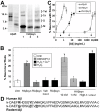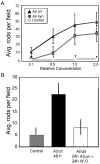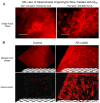Amyloid beta dimers/trimers potently induce cofilin-actin rods that are inhibited by maintaining cofilin-phosphorylation
- PMID: 21261978
- PMCID: PMC3037337
- DOI: 10.1186/1750-1326-6-10
Amyloid beta dimers/trimers potently induce cofilin-actin rods that are inhibited by maintaining cofilin-phosphorylation
Abstract
Background: Previously we reported 1 μM synthetic human amyloid beta1-42 oligomers induced cofilin dephosphorylation (activation) and formation of cofilin-actin rods within rat hippocampal neurons primarily localized to the dentate gyrus.
Results: Here we demonstrate that a gel filtration fraction of 7PA2 cell-secreted SDS-stable human Aβ dimers and trimers (Aβd/t) induces maximal neuronal rod response at ~250 pM. This is 4,000-fold more active than traditionally prepared human Aβ oligomers, which contain SDS-stable trimers and tetramers, but are devoid of dimers. When incubated under tyrosine oxidizing conditions, synthetic human but not rodent Aβ1-42, the latter lacking tyrosine, acquires a marked increase (620 fold for EC50) in rod-inducing activity. Gel filtration of this preparation yielded two fractions containing SDS-stable dimers, trimers and tetramers. One, eluting at a similar volume to 7PA2 Aβd/t, had maximum activity at ~5 nM, whereas the other, eluting at the void volume (high-n state), lacked rod inducing activity at the same concentration. Fractions from 7PA2 medium containing Aβ monomers are not active, suggesting oxidized SDS-stable Aβ1-42 dimers in a low-n state are the most active rod-inducing species. Aβd/t-induced rods are predominantly localized to the dentate gyrus and mossy fiber tract, reach significance over controls within 2 h of treatment, and are reversible, disappearing by 24 h after Aβd/t washout. Overexpression of cofilin phosphatases increase rod formation when expressed alone and exacerbate rod formation when coupled with Aβd/t, whereas overexpression of a cofilin kinase inhibits Aβd/t-induced rod formation.
Conclusions: Together these data support a mechanism by which Aβd/t alters the actin cytoskeleton via effects on cofilin in neurons critical to learning and memory.
Figures







Similar articles
-
Incorporation of cofilin into rods depends on disulfide intermolecular bonds: implications for actin regulation and neurodegenerative disease.J Neurosci. 2012 May 9;32(19):6670-81. doi: 10.1523/JNEUROSCI.6020-11.2012. J Neurosci. 2012. PMID: 22573689 Free PMC article.
-
Amyloid-β and proinflammatory cytokines utilize a prion protein-dependent pathway to activate NADPH oxidase and induce cofilin-actin rods in hippocampal neurons.PLoS One. 2014 Apr 23;9(4):e95995. doi: 10.1371/journal.pone.0095995. eCollection 2014. PLoS One. 2014. PMID: 24760020 Free PMC article.
-
Chemokine Receptor Antagonists Prevent and Reverse Cofilin-Actin Rod Pathology and Protect Synapses in Cultured Rodent and Human iPSC-Derived Neurons.Biomedicines. 2024 Jan 1;12(1):93. doi: 10.3390/biomedicines12010093. Biomedicines. 2024. PMID: 38255199 Free PMC article.
-
Actin dynamics and cofilin-actin rods in alzheimer disease.Cytoskeleton (Hoboken). 2016 Sep;73(9):477-97. doi: 10.1002/cm.21282. Epub 2016 Mar 1. Cytoskeleton (Hoboken). 2016. PMID: 26873625 Free PMC article. Review.
-
Cellular prion protein: A co-receptor mediating neuronal cofilin-actin rod formation induced by β-amyloid and proinflammatory cytokines.Prion. 2014;8(6):375-80. doi: 10.4161/pri.35504. Prion. 2014. PMID: 25426519 Free PMC article. Review.
Cited by
-
Incorporation of cofilin into rods depends on disulfide intermolecular bonds: implications for actin regulation and neurodegenerative disease.J Neurosci. 2012 May 9;32(19):6670-81. doi: 10.1523/JNEUROSCI.6020-11.2012. J Neurosci. 2012. PMID: 22573689 Free PMC article.
-
Identification of actin mutants with neurodegenerative disease-like phenotypes via mutagenesis of the actin-ATP interface.Front Cell Neurosci. 2025 Jun 4;19:1543199. doi: 10.3389/fncel.2025.1543199. eCollection 2025. Front Cell Neurosci. 2025. PMID: 40535610 Free PMC article.
-
The potential role of rho GTPases in Alzheimer's disease pathogenesis.Mol Neurobiol. 2014 Oct;50(2):406-22. doi: 10.1007/s12035-014-8637-5. Epub 2014 Jan 23. Mol Neurobiol. 2014. PMID: 24452387 Review.
-
CofActor: A light- and stress-gated optogenetic clustering tool to study disease-associated cytoskeletal dynamics in living cells.J Biol Chem. 2020 Aug 7;295(32):11231-11245. doi: 10.1074/jbc.RA119.012427. Epub 2020 May 18. J Biol Chem. 2020. PMID: 32424038 Free PMC article.
-
Aβ Influences Cytoskeletal Signaling Cascades with Consequences to Alzheimer's Disease.Mol Neurobiol. 2015 Dec;52(3):1391-1407. doi: 10.1007/s12035-014-8913-4. Epub 2014 Oct 26. Mol Neurobiol. 2015. PMID: 25344315 Review.
References
-
- Sisodia SS, Price DL. Role of the beta-amyloid protein in Alzheimer's disease. FASEB J. 1995;9:366–370. - PubMed
Grants and funding
LinkOut - more resources
Full Text Sources

